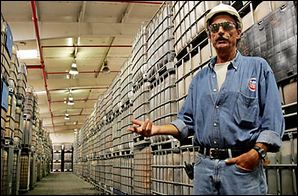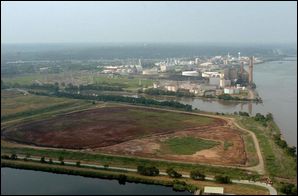|

Dioxins
all around us
Reports link the chemical
byproduct to cancer and other ailments — and Delaware leads the
United States in production of it and PCBs.
A recent national report that stressed links between dioxin and
cancer is raising concerns in Delaware, where thousands of tons
of dioxin-tainted wastes have been spilled, buried or stored.
Delaware ranks No. 1 in the nation in the production of dioxins,
furans and dioxinlike polychlorinated biphenyls, industrial byproducts
that in some cases are routinely trickled into the Delaware River.

The News Journal/RON SOLIMAN
Doug Fox of the Environmental Protection Agency is involved
in the cleanup of the former Metachem Products plant near Delaware
City. The owners declared bankruptcy and abandoned the chemicals
in the background to the government in 2002.
The Edge Moor wastewater plant, the Delaware City refinery and
the Wilmington Amtrak repair shops are among the region's top
sources of dioxins and dioxinlike PCBs.
The National Academy of Sciences recently confirmed that dioxin
is highly toxic and known or likely to cause cancer. Exposure
also can lead to birth defects and other health problems.
One now-shuttered Delaware City business, the former Standard
Chlorine of Delaware Inc., supplied and then recycled some of
the chemicals used to produce the herbicide Agent Orange, a defoliant
that made dioxin a household word after the Vietnam War.

Steve Tindall, who lives near DuPont's Edge Moor plant, says
it's time to drop old standards.
Experts say this puts Vietnam veterans in Delaware at double
the risk for exposure.
"Delawareans have probably been more heavily exposed to
dioxin than most other populations," said Alan Muller, who
directs the environmental group Green Delaware. "Given the
near total inaction in Delaware on dioxin-related issues, these
reports confirm the need for much more aggressive and timely action
to protect the public."
Environmental activist Lois Gibbs, executive director of the
Center for Health, Environment & Justice in Falls Church,
Va., has made several trips to Delaware and New Jersey over the
years to argue against proposals to pump dioxin wastes into the
Delaware River.
Gibbs said the new report may help government agencies get tough
with polluters.
"The chemical industry has been stalling the release of
this information for 21 years," she said. "Now that
it's out, agencies can start building policies for cleanups."

News Journal file/JENNIFER CORBETT
DuPont's Edge Moor plant waste site lies on the banks of the
Delaware River.
Dioxins, furans and dioxin-like PCBs "are detected at low
concentrations in virtually all organisms," scientists have
found.
In humans, the toxins can cause skin lesions, liver disease and
possibly cancer. Other health effects can include thyroid and
blood disorders, neurological problems, heart disease, diabetes
and other metabolic disorders.
Late last month, another report, this one issued by the World
Health Organization, upgraded the risk associated with a chemical
found in huge amounts at DuPont's Edge Moor plant.
The state is examining the report to see what, if anything, needs
to be done.
"We're going to look at it and we may have to have our third-party
contractor [for the Edge Moor cleanup] look at it," said
Kathy Stiller-Banning, a Department of Natural Resources and Environmental
Control program manager.
Edge Moor's plant ranks as the nation's largest producer of dioxin
byproducts, a fact that led to a series of cleanup proposals and
reviews of plant operating methods.
Company, state and community officials have for years debated
options for removing or containing a 15-acre, 500,000-ton pile
of dioxin-tainted leftovers from ore processing.
DuPont is evaluating the new study as well, said, Eddie Johnston,
a manager at DuPont's Titanium Technologies Business. "We
have just received the report ourselves," he said.
DNREC was not immediately able to list other dioxin-contaminated
sites in the state.
Earlier studies
misleading
Dioxins, furans and PCBs most often form as unwanted byproducts
in chemical processes involving chlorine and high temperatures.
Delaware, once at the center of the nation's largest chemical
complex, had several such industries, including Edge Moor, Standard
Chlorine of Delaware and its successor, Metachem Products.
State and federal cleanup studies in Delaware have been complicated
because low levels of dioxins are routinely found in the environment,
making it harder to link contamination to individual polluters.
Rick Hind, toxic programs director for the environmental group
Greenpeace USA, said the new academy report ranks dioxins as a
major global concern.
"What the report does say is that cleanups of dioxin contamination
need to go ahead and need to be more strict," Hind said.
"That could have a very specific impact on the cleanup of
the mountain of dioxin at the DuPont plant in Wilmington."
The EPA singled out Edge Moor for close attention in the late
1990s after finding that some of DuPont's practices produced dioxins
and wastes that deserved a "hazardous" label and special
disposal restrictions. That created a public controversy over
DuPont's plan to permanently seal a 15-acre waste pile along the
river east of Wilmington.
DuPont officials argued that the dioxins at Edge Moor are a weaker
cousin of the most dangerous variety and can remain on site under
a protective liner forever.
However, the World Health Organization report released June 27
said dioxins like those at Edge Moor should be considered three
to 10 times more hazardous than previously acknowledged.
Steve Tindall, a resident of the Cragmere neighborhood northwest
of the Edge Moor plant, said Delaware should take the new report
seriously. "I would be concerned if they were using old standards
when something state of the art is available," he said.
Metachem cleanup
Even higher dioxin concentrations were found at the bankrupt
Metachem Products chemical plant north of Delaware City. It's
now the site of a federal cleanup that could cost taxpayers $100
million or more.
Metachem took over the plant from Standard Chlorine in 1998 and
then abruptly shut it down, leaving a 75-acre toxic-waste cleanup
problem and more than $60 million in unpaid bills.
State officials have said some unapproved practices at the factory
increased the chance of creating unwanted dioxin or PCBs. The
risks were underscored in 2003, when a Delaware River Basin Commission
described Metachem as one of the region's top sources of PCB-tainted
runoff to the Delaware River.
Marvin Olson, a Vietnam veteran and longtime resident of the
Emerald Ridge neighborhood northwest of the Metachem plant, said
odors have dwindled from the factory since the shutdown. He nevertheless
criticized regulators for failing to act on known pollution problems.
"I saw the effects of Agent Orange in Vietnam and in veterans
today," Olson said. "I don't think they're doing what
they need to to make it necessary for these kinds of places to
actually make changes. They're giving them too long a lead time.
I work at a nuclear plant, and if we operated the way they do
here, we'd be shut down."
The EPA spent millions of dollars processing the abandoned chemicals
at Metachem and turning out thousands of huge cubes, three feet
on a side.
Those cubes are stored at a warehouse near Delaware City, awaiting
money to pay for their transfer to one of several toxic-waste
incinerators in the nation.
Contact Jeff Montgomery at 678-4277 or jmontgomery@delawareonline.com.
Contact Mike Billington at 324-2761 or mbillington@delawareonline.com.
|